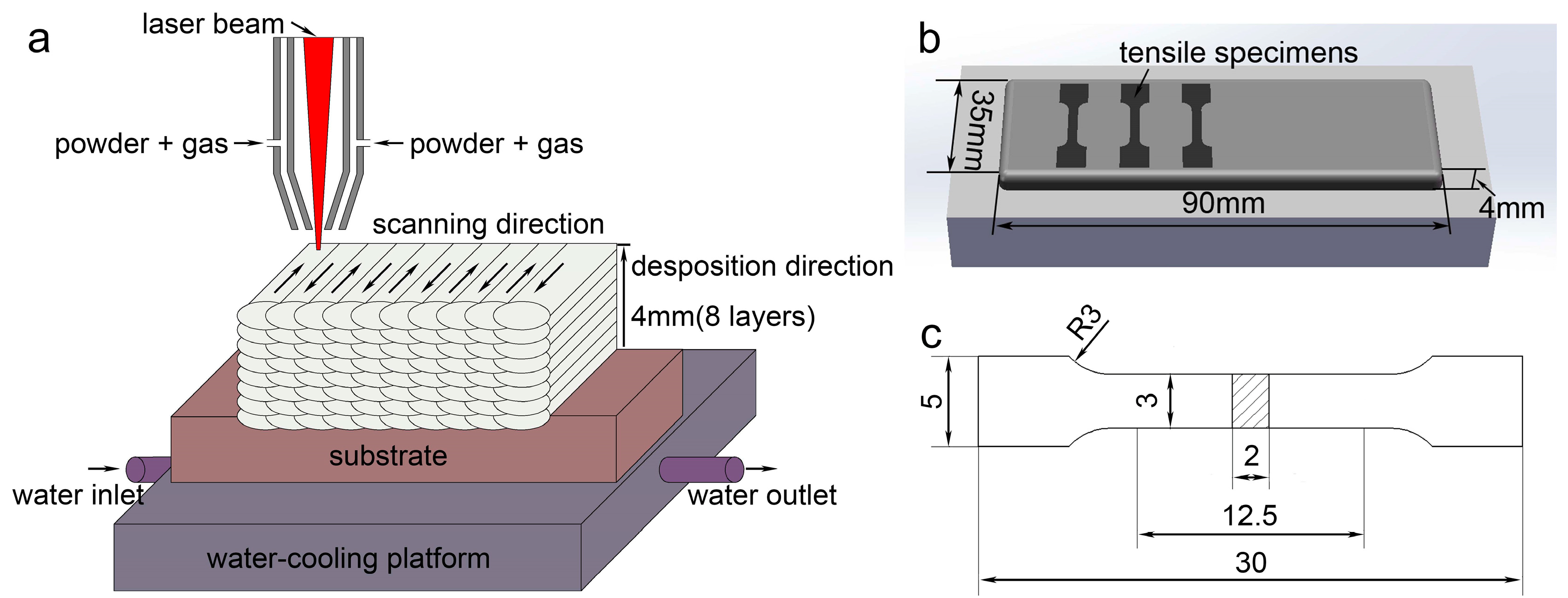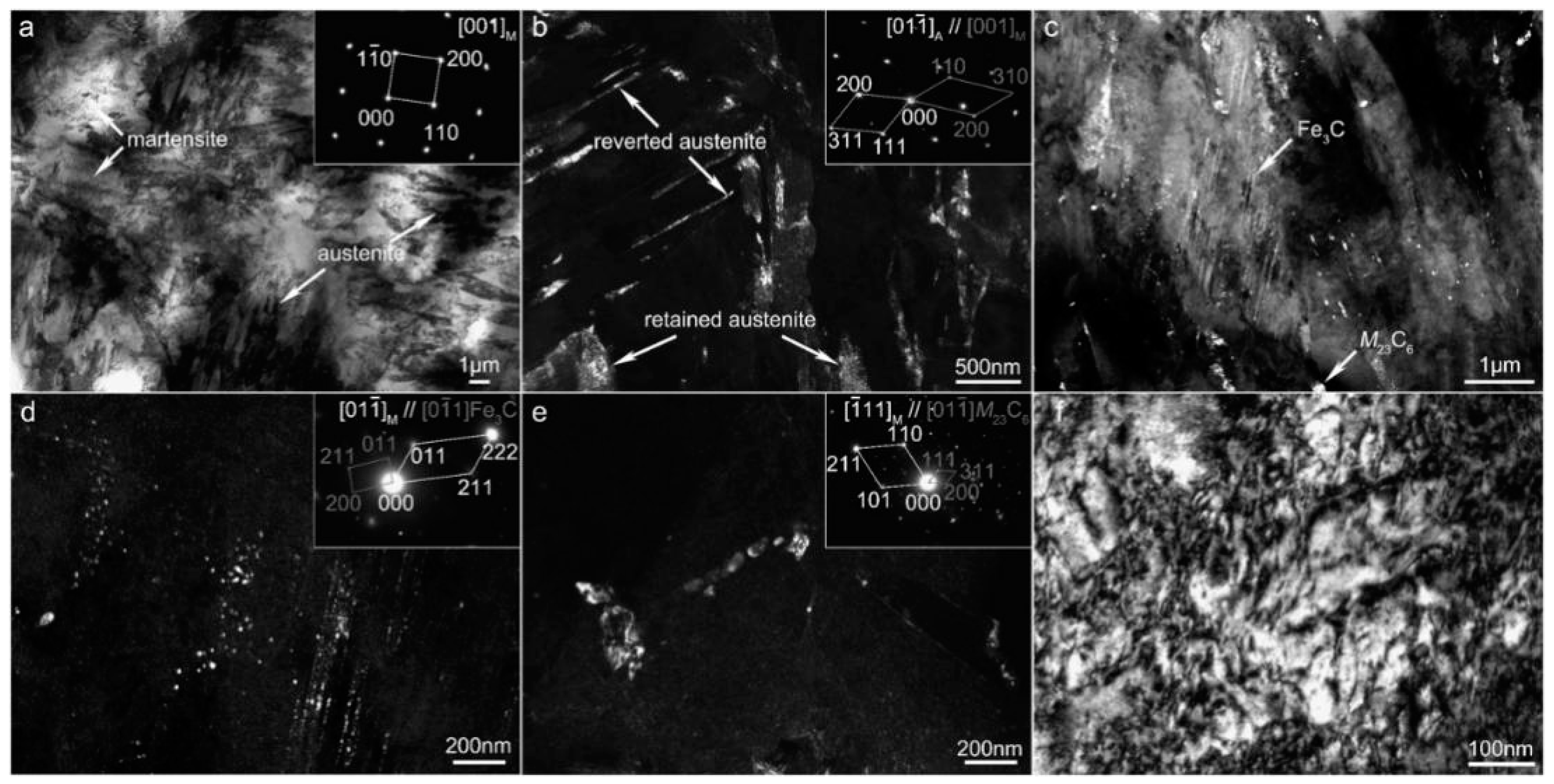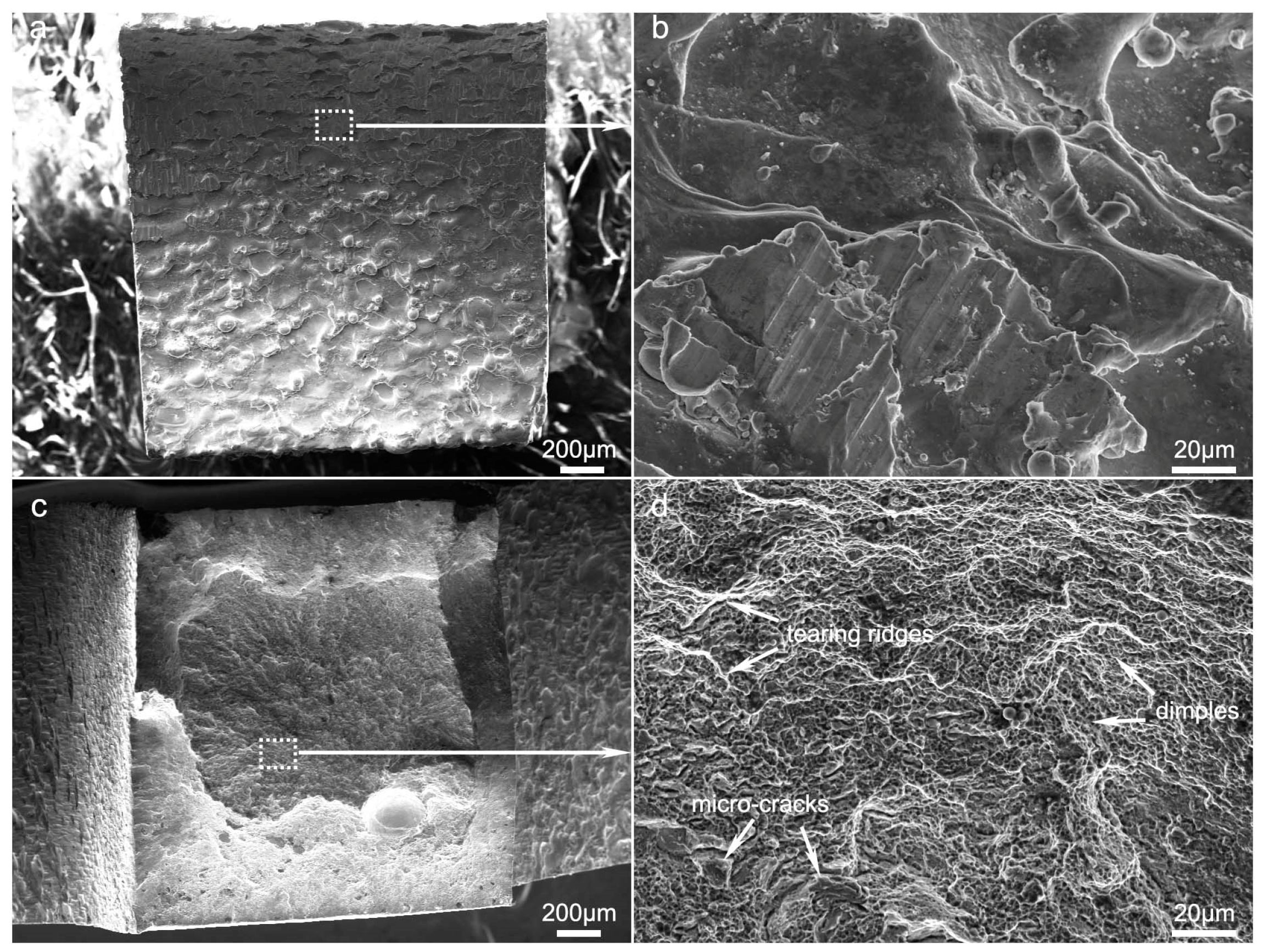Effects of Low-Temperature Tempering on Microstructure and Properties of the Laser-Cladded AISI 420 Martensitic Stainless Steel Coating
Abstract
:1. Introduction
2. Materials and Methods
2.1. Materials
2.2. Coating Preparation and Heat Treatment
2.3. Characterization
3. Results
3.1. Phase Analysis
3.2. Microstructure Characterization
3.3. Mechanical Properties
3.4. Electrochemical Properties
4. Conclusions
- The phase constituents of both the pre- and post- laser-cladded AISI 420 SS coatings were mainly martensite, austenite, nano-sized Fe3C and M23C6 carbides. After tempering treatment, the martensite was refined and the dislocation density was decreased, along with the massive formation of the reverse austenite and nano-sized Fe3C carbides.
- The low-temperature tempering treatment caused a slight decrease (6%–10%) in micro-hardness and strength, but a significant increase (1.6 times) in the ductility of the laser-cladded coating. The as-tempered AISI 420 SS coating exhibited striking mechanical properties with a UTS of 1690 MPa, YS0.2 of 1109 MPa and elongation of 15.8%, superior to the laser-cladded Fe-based SS coatings reported in the literature.
- Both the pre- and post-tempered specimens exhibited a similar corrosion resistance with the bulk AISI 420 SS. However, the corrosion resistance was slightly decreased after tempering.
Author Contributions
Funding
Conflicts of Interest
References
- Zhu, H.; Li, B.; Chen, M.; Qiu, C.; Tang, Z. Improvement of corrosion resistance of Hastelloy-N alloy in LiF-NaF-KF molten salt by laser cladding pure metallic coatings. Coatings 2018, 8, 322. [Google Scholar] [CrossRef]
- Sun, S.D.; Fabijanic, D.; Ghaderi, A.; Leary, M.; Toton, J.; Sun, S.; Brandt, M.; Easton, M. Microstructure and hardness characterisation of laser coatings produced with a mixture of AISI 420 stainless steel and Fe-C-Cr-Nb-B-Mo steel alloy powders. Surf. Coat. Technol. 2016, 296, 76–87. [Google Scholar] [CrossRef]
- Krakhmalev, P.; Yadroitsava, I.; Fredriksson, G.; Yadroitsev, I. In situ heat treatment in selective laser melted martensitic AISI 420 stainless steels. Mater. Des. 2015, 87, 380–385. [Google Scholar] [CrossRef]
- Zhang, Z.; Farahmand, P.; Kovacevic, R. Laser cladding of 420 stainless steel with molybdenum on mild steel A36 by a high power direct diode laser. Mater. Des. 2016, 209, 686–699. [Google Scholar] [CrossRef]
- Zhang, Z.; Yu, T.; Kovacevic, R. Erosion and corrosion resistance of laser cladded AISI 420 stainless steel reinforced with VC. Appl. Surf. Sci. 2017, 410, 225–240. [Google Scholar] [CrossRef]
- Alam, M.K.; Edrisy, A.; Urbanic, J.; Pineault, J. Microhardness and stress analysis of laser-cladded AISI 420 martensitic stainless steel. J. Mater. Eng. Perform. 2017, 26, 1076–1084. [Google Scholar] [CrossRef]
- Sun, S.D.; Fabijanic, D.; Barr, C.; Liu, Q.; Walker, K.; Matthews, N.; Orchowski, N.; Easton, M.; Brandt, M. In-situ quench and tempering for microstructure control and enhanced mechanical properties of laser cladded AISI 420 stainless steel powder on 300M steel substrates. Surf. Coat. Technol. 2018, 333, 210–219. [Google Scholar] [CrossRef]
- Saha, D.; Biro, E.; Gerlich, A.P.; Zhou, Y. Effects of tempering mode on the structural changes of martensite. Mater. Sci. Eng. A 2016, 673, 467–475. [Google Scholar] [CrossRef]
- ASTM Standard E8/E8M-15a: Standard Test Methods for Tension Test of Metallic Materials; ASTM International: West Conshohocken, PA, USA, 2015.
- Li, K.; Li, D.; Liu, D.; Peng, G.; Sun, L. Microstructure evolution and mechanical properties of multiple-layer laser cladding coating of 308L stainless steel. Appl. Surf. Sci. 2015, 340, 143–150. [Google Scholar] [CrossRef]
- Zhang, Y.; Zhan, D.; Qi, X.; Jiang, Z. Austenite and precipitation in secondary-hardening ultra-high-strength stainless steel. Mater. Charact. 2018, 144, 393–399. [Google Scholar] [CrossRef]
- Hengsbach, F.; Koppa, P.; Duschik, K.; Holzweissig, M.J.; Burns, M.; Nellesen, J.; Tillmann, W.; Tröster, T.; Hoyer, K.P.; Schaper, M. Duplex stainless steel fabricated by selective laser melting-microstructural and mechanical properties. Mater. Des. 2017, 133, 136–142. [Google Scholar] [CrossRef]
- Lu, S.Y.; Yao, K.F.; Chen, Y.B.; Wang, M.H.; Liu, X.; Ge, X.Y. The effect of tempering temperature on the microstructure and electrochemical properties of a 13 wt.% Cr-type martensitic stainless steel. Electrochim. Acta 2015, 165, 45–55. [Google Scholar] [CrossRef]
- Liu, F.; Lin, X.; Song, M.; Yang, H.; Song, K.; Guo, P. Effect of tempering temperature on microstructure and mechanical properties of laser solid formed 300M steel. J. Alloy. Compd. 2016, 689, 225–232. [Google Scholar] [CrossRef]
- Bonagani, S.K.; Bathula, V.; Kain, V. Influence of tempering treatment on microstructure and pitting corrosion of 13 wt.% Cr martensitic stainless steel. Corros. Sci. 2018, 131, 340–354. [Google Scholar] [CrossRef]
- Peng, W.W.; Zeng, W.D.; Kang, C.; Jia, Z.Q. Effect of heat treatment on microstructure and properties of 300M ultrahigh strength steel. Trans. Mater. Heat Treat. 2012, 3, 017. [Google Scholar]
- Fang, J.X.; Dong, X.Y.; Wang, Y.J.; Xu, B.S.; Zhang, Z.H.; Xia, D.; Ren, W.B.; He, P. Microstructure and properties of an as-deposited and heat treated martensitic stainless steel fabricated by direct laser deposition. J. Manuf. Process. 2017, 25, 402–410. [Google Scholar] [CrossRef]
- Liu, Y.; Li, A.; Cheng, X.; Zhang, S.; Wang, H. Effects of heat treatment on microstructure and tensile properties of laser melting deposited AISI 431 martensitic stainless steel. Mater. Sci. Eng. A 2016, 666, 27–33. [Google Scholar] [CrossRef]
- Song, Y.; Li, X.; Rong, L.; Ping, D.; Yin, F.; Li, Y. Formation of the reversed austenite during intercritical tempering in a Fe-13% Cr-4% Ni-Mo martensitic stainless steel. Mater. Lett. 2010, 64, 1411–1414. [Google Scholar] [CrossRef]
- Saeidi, K.; Kevetkova, L.; Lofaj, F.; Shen, Z. Novel ferritic stainless steel formed by laser melting from duplex stainless steel powder with advanced mechanical properties and high ductility. Mater. Sci. Eng. A 2016, 665, 59–65. [Google Scholar] [CrossRef]
- Sun, G.; Zhang, Y.; Zhang, M.; Zhou, R.; Wang, K.; Liu, C.; Luo, K. Microstructure and corrosion characteristics of 304 stainless steel laser-alloyed with Cr-CrB2. Appl. Surf. Sci. 2014, 295, 94–107. [Google Scholar] [CrossRef]








| Element | Chemical Composition (wt.%) |
|---|---|
| C | 0.26 |
| Cr | 13.15 |
| Ni | 0.55 |
| Mn | 1.02 |
| Si | 0.97 |
| Fe | Bal. |
| Coatings | Treatment States | UTS (MPa) | YS0.2 (MPa) | Elongation (%) | Ref. |
|---|---|---|---|---|---|
| AISI 420 | as-cladded | 1802 | 1306 | 6.9 | This work |
| AISI 420 | as-tempered (210 °C, 1 h) | 1690 | 1109 | 15.8 | This work |
| AISI 431 | as-tempered (680 °C, 2 h) | 905 ± 6 | – | 16.3 ± 0.8 | [18] |
| AISI 431 | as-heat treated (1050 °C, 45 min, oil-quenching + 315 °C, 3 h, tempering) | 1283 ± 16 | – | 14.5 ± 1.5 | [18] |
| SAF2507 | as-cladded | 1321 ± 48 | 1214 ± 43 | 8.6 ± 1 | [19] |
| AISI 308L | as-cladded | 548 | 377 | 40 | [20] |
| UNS S31803 | as-cladded | 940 | 890 | 12 | [12] |
| UNS S31803 | as-annealed (1000 °C, 5 min) | 770 | 600 | 28 | [12] |
| Specimens | Ecorr (V) | Icorr (A·cm−2) | Corrosion Rate (mm·a−1) |
|---|---|---|---|
| AISI 420 SS as-cladded coating | −0.5813 | 3.838 × 10−6 | 0.03723 |
| AISI 420 SS as-tempered coating | −0.6671 | 4.271× 10−6 | 0.04194 |
| Bulk AISI 420 SS | −0.4368 | 3.630 × 10−6 | 0.03066 |
© 2018 by the authors. Licensee MDPI, Basel, Switzerland. This article is an open access article distributed under the terms and conditions of the Creative Commons Attribution (CC BY) license (http://creativecommons.org/licenses/by/4.0/).
Share and Cite
Zhu, H.; Li, Y.; Li, B.; Zhang, Z.; Qiu, C. Effects of Low-Temperature Tempering on Microstructure and Properties of the Laser-Cladded AISI 420 Martensitic Stainless Steel Coating. Coatings 2018, 8, 451. https://doi.org/10.3390/coatings8120451
Zhu H, Li Y, Li B, Zhang Z, Qiu C. Effects of Low-Temperature Tempering on Microstructure and Properties of the Laser-Cladded AISI 420 Martensitic Stainless Steel Coating. Coatings. 2018; 8(12):451. https://doi.org/10.3390/coatings8120451
Chicago/Turabian StyleZhu, Hongmei, Yongzuo Li, Baichun Li, Zhenyuan Zhang, and Changjun Qiu. 2018. "Effects of Low-Temperature Tempering on Microstructure and Properties of the Laser-Cladded AISI 420 Martensitic Stainless Steel Coating" Coatings 8, no. 12: 451. https://doi.org/10.3390/coatings8120451




